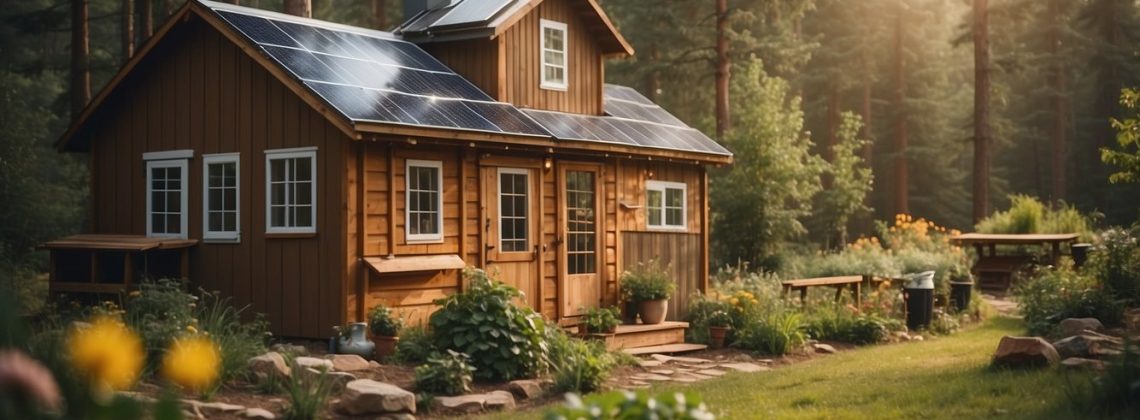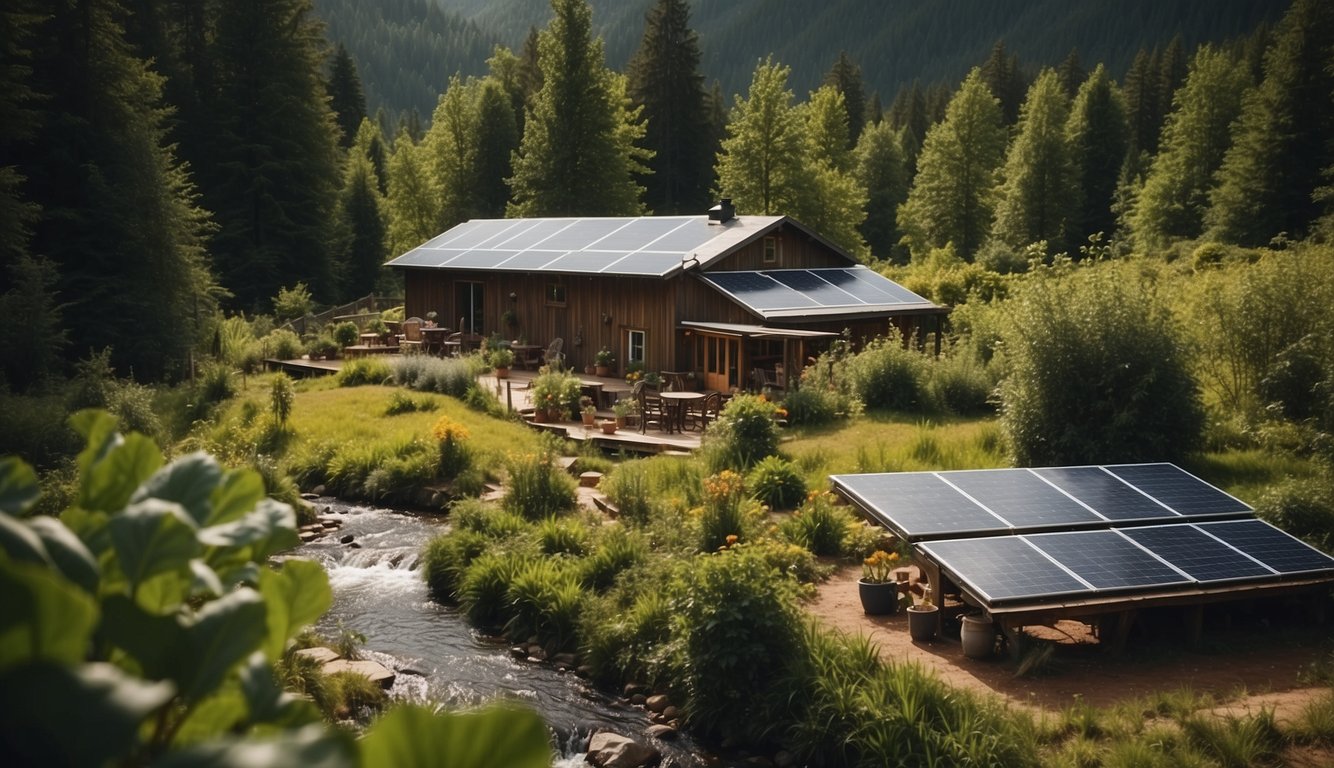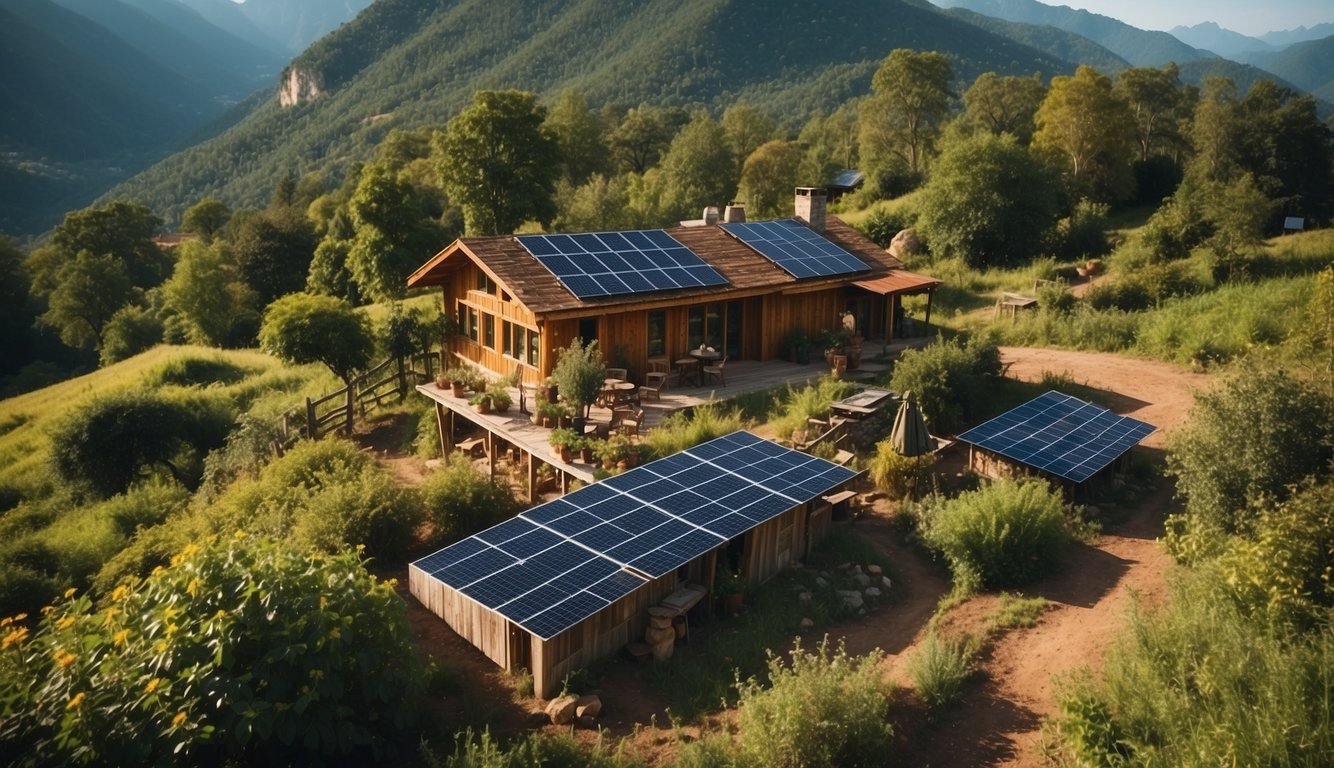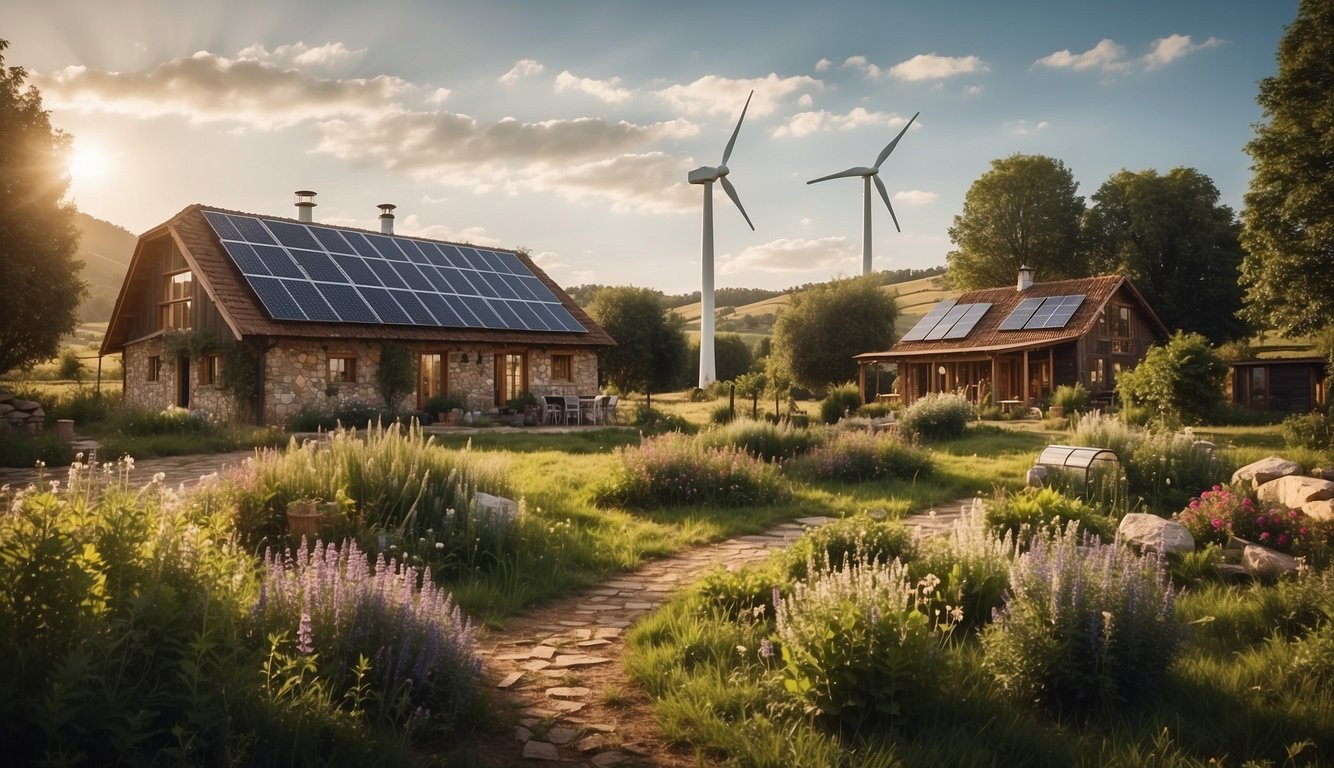
Off-grid living embodies the essence of self-sufficiency, creating a sustainable lifestyle that’s both challenging and rewarding. Trading modern conveniences for a deeper connection with nature, you’ll embark on a journey that demands skill, determination, and versatility. Embracing off-grid living means developing a wide array of competencies, from food preservation to energy management, all aimed at building a lifestyle that can withstand the ebb and flow of external dependencies.
Embarking on this path, you’ll realize that the heart of off-grid homesteading is not just about surviving but thriving independently. This transition calls for strategic planning and learning new skills to ensure your homestead can fulfill the needs of a sustainable and autonomous life. Whether it’s through setting up a rainwater harvesting system, establishing renewable energy sources, or fostering a fertile garden, the move to off-grid living is a testament to human ingenuity and resilience.
Key Takeaways
- Off-grid living requires a comprehensive skill set and careful planning.
- Self-sufficiency involves sustainable practices in food, water, and energy.
- Independent living is bolstered by community engagement and continuous learning.
Understanding Off-Grid Living
In this deep dive into off-grid living, you’ll discover what it truly means to live self-sufficiently and the benefits that come with a lifestyle closely tied with nature. Get ready to learn the essentials of powering your homestead with alternative energy and securing your own water source.
What is Off-Grid Living?
Off-grid living means setting up a life that’s independent of public utilities. You’ll generate your own power, often through solar panels or wind turbines, and you’ll have a self-managed water source like a well or a nearby stream. Living off-grid requires securing a piece of land that can support these activities and your overall self-sufficient goals. It’s a hands-on approach where you’re in charge of your essentials: electricity, water, and often food.
- Power Generation:
- Solar: Utilize solar panels to capture energy from the sun.
- Wind: Harness the power of the wind with turbines.
- Water Source:
- Well or stream for a reliable supply of water.
Benefits of a Self-Sufficient Lifestyle
Embracing the off-grid life means tapping into a host of benefits. You’re not just cutting ties with utility companies, you’re also fostering a sustainable way of living that’s kinder to the planet. With self-sufficiency:
- You gain independence from fluctuating utility prices and outages.
- Your environmental impact shrinks as you rely on renewable resources like solar and wind.
- You develop skills that enhance your resilience, making you well-prepared for various scenarios.
Remember, becoming self-sufficient doesn’t happen overnight, but the payoff is a lifestyle that aligns closely with sustainability and personal independence.
Preparing Your Homestead

Before you embark on your off-grid journey, nailing down the specifics of your homestead’s infrastructure is vital. From choosing the piece of land that will become your haven to ensuring your water and sanitation needs are met, preparation is the key to a sustainable lifestyle.
Choosing the Right Land
Your journey begins with finding the perfect slice of earth. You want land that’s not just beautiful, but practical. Consider soil fertility for crops, exposure to sunlight for solar panels, and the presence of a natural water source. Proximity to a water source, like a stream or lake, could be crucial – but don’t forget to check local regulations on water rights. Your land should also offer:
- Sufficient space for gardening and livestock.
- Natural resources for building materials and fuel.
- Accessibility throughout the year, think about roads and pathways.
Designing Your Off-Grid Home
When designing your home, align it with your sustainable goals. Think about:
- Solar orientation: Maximize sunlight for warmth and energy.
- Materials: Use local, sustainable materials to reduce your carbon footprint.
- Insulation: Proper insulation keeps energy needs low.
Implement renewable energy sources such as solar panels or wind turbines early in your design process. Also, consider the layout of your home—open floor plans help heat move freely, reducing heating costs.
Planning for Water and Sanitation Needs
Water is life, so plan your water and sanitation meticulously. For water sourcing, you have a few options:
- Digging a well: This is a consistent water source, but costly upfront.
- Rainwater harvesting: Collect and store rainwater using gutters and tanks.
For sanitation:
- Septic system: If you’re far from municipal sewage, a septic system is likely necessary. Ensure it is professionally designed to handle your household’s needs.
- Composting toilets: Reduce water usage and produce compost for your garden.
Remember that proper planning and sustainable practices are the foundation of a successful off-grid homestead.
Sustainable Food Production

Achieving self-sufficiency on your homestead centers around reliable and varied food sources. Let’s dive into how you can cultivate your garden, raise animals, and find nutrition in the wild.
Starting Your Garden
First off, kick-start your garden with survival seeds for a range of vegetables and fruit. Picking seasonal and native plants not only enhances growth success but also fits with ecological patterns. A good rule of thumb:
- Pick high-yield seeds to maximize space.
- Integrate companion planting to naturally fend off pests.
Raising Livestock and Poultry
Next, consider raising livestock such as goats for milk and chickens for a steady supply of meat and eggs. Remember:
- Chickens require less space and can be ideal for small-scale homesteads.
- Ensure a secure and comfortable environment to keep them healthy and productive.
Foraging and Hunting for Food
Don’t overlook nature’s bounty. Foraging for edibles like berries and hunting for wild game can supplement your food sources. Safely embrace these practices by:
- Learning about local flora to safely identify edible wild plants.
- Obtaining the necessary permits and understanding regional hunting laws.
Keep in mind, all of these efforts will assist in establishing a sustainable source of nourishment on your homestead.
Water Collection and Management

In off-grid living, managing your water supply is crucial. You’re in charge of how you collect, purify, and distribute water for all your needs. It’s not just about having a water source; it’s about ensuring that every drop counts, from rainwater to irrigation.
Rainwater Harvesting
Rainwater is an excellent primary or supplementary water source. Here’s how to get started:
- Catchment Area: Use your roof as a catchment area. The larger the surface, the more water you can collect.
- Storage: Store rainwater in large barrels or tanks. Remember to cover them to prevent contamination and mosquitos.
- First Flush Diverter: Install a first flush system to divert the initial rain, which typically carries the most debris and contaminants.
Water Purification
Before you use your collected water, it’s critical to purify it:
- Boiling: Boil water for at least one minute to kill most pathogens.
- Filters: Use a filtration system to remove particles and some contaminants. You can find systems designed for home-scale use.
- Chemical Treatment: As a last resort or additional step, chemical treatments such as chlorine or iodine can be used but follow instructions closely to avoid harmful concentrations.
Irrigation Systems
If you’re growing your own food, an efficient irrigation system is vital:
- Drip Irrigation: A drip system delivers water directly to the plant base, reducing water waste.
- Rain Barrels: Connect rain barrels to your irrigation system to take advantage of rainwater.
- Timers: Use timers to water during the cool parts of the day and minimize evaporation.
Each of these elements plays a critical role in maintaining a sustainable and self-sufficient homestead. Remember, plan according to your local climate and water availability, so you’re never without this essential resource.
Energy Solutions and Management

When you’re living off the grid, your energy independence hinges on the right mix of renewable resources and smart energy management. You’ll need to tap into sustainable sources like the sun and wind, back them up with generators and batteries, and adopt energy conservation practices to stretch your supplies.
Harnessing Solar and Wind Power
You’ve got the power of nature at your fingertips with solar panels and wind turbines. Solar panels convert sunlight into electricity, perfect for sunny days, while wind turbines capture the breeze to keep the juice flowing. Here’s a quick look at both:
Solar Power:
- Peak Hours: Aim for installation in areas that get full sun exposure, especially during peak sunlight hours.
- Maintenance: Keep those panels clean for maximum efficiency.
Wind Power:
- Location: The higher the turbine, the better; catch those stronger winds above ground level.
- Size: Bigger isn’t always better; tailor your turbine size to your specific energy needs.
Remember, these renewable energy sources can fluctuate, so it’s crucial to balance your consumption with the availability of sunlight and wind.
Using Generators and Batteries
In your quest for self-sufficiency, generators and batteries act as your safety net. Generators can power through cloudy or windless spells, while the Tesla Powerwall or similar batteries store excess energy for later use.
Generators:
- Fuel: Opt for a fuel-efficient model to save on costs and reduce the need for fuel storage.
- Usage: Save your generator for those critical moments to extend its lifespan.
Batteries:
- Capacity: Choose batteries with enough capacity to cover your evening usage or multiple cloudy days.
- Quality: Invest in high-quality batteries to ensure longevity and better performance.
Striking a balance between generation and storage keeps you powered up, no matter what nature throws your way.
Energy Conservation Techniques
Your energy is precious, so make every watt count. Energy conservation extends your resources and diminishes the need for constant generation. Simple practices can have a significant impact:
- LEDs: Swap out old bulbs for LED lighting, which uses a fraction of the electricity.
- Appliance Usage: Run power-hungry appliances like washing machines during peak generation times.
- Insulation: Good insulation keeps your homestead warm in winter and cool in summer, reducing heating and cooling energy demands.
By focusing on efficiency, you’ll find living off the grid more sustainable and rewarding. Make renewable energy and conservation the cornerstones of your homestead, and you’ll be on your way to a self-sufficient lifestyle.
DIY and Home Maintenance

In off-grid living, your hands are your greatest tools. Knowing how to maintain your home and tackle DIY projects is crucial for self-sufficiency. From construction to regular upkeep, your skills ensure your homestead remains robust and sustainable.
Building and Construction Skills
Know Your Materials: To start, get familiar with the basics – lumber, nails, screws, and adhesives. You’ll use these for everything from building a chicken coop to crafting custom shelving.
Essential Tools: Arm yourself with a hammer, saw, drill, and measuring tape. These tools are indispensable for day-to-day tasks as well as unexpected repairs or builds.
Regular Homestead Repairs
Stay Vigilant: Regularly inspect your property for issues. Fix leaks promptly to prevent water damage and insulate pipes to avoid freezing.
Repair Schedule: Keep a schedule for tasks like oiling hinges, re-coating surfaces, and clearing gutters. Maintenance prevents problems before they start.
DIY Projects for Self-Reliance
- Rainwater Collection System: Collect and utilize rainwater with DIY gutters and storage tanks.
- Solar Solutions: Create simple solar power setups to harness renewable energy.
Prioritize projects that increase your independence, and invest time in learning skills to maintain your homestead effectively.
Financial Planning and Budgeting

Effective financial planning and budgeting are your bedrock for successful off-grid living. It’s not just about saving money; it’s about creating a sustainable lifestyle that aligns with your homesteading goals and supports your family’s needs.
Creating a Homesteading Budget
Step 1: Calculate Your Initial Costs
To kick things off, you’ll need to total up your starting expenses. This includes:
- Land purchase or costs for current residence
- Construction or renovation of your homestead
- Off-grid system setup (solar panels, water filtration, etc.)
- Seeds, livestock, and initial farming supplies
Step 2: Track Your Monthly Expenses
Here’s a basic table to record your recurring expenses:
| Month | Groceries | Utilities | Property Taxes | Other Necessities | Total |
|---|---|---|---|---|---|
| Example | $300 | $0 | $50 | $150 | $500 |
Step 3: Plan for Savings and Emergencies
Put aside a slice of your income for unexpected costs and future projects to ensure you’re not caught off guard.
Generating Income Off the Grid
Diversify Your Income Streams:
- Remote Work: Engage in online freelance gigs or remote positions that suit your skill set.
- Homestead Products: Sell your surplus produce, homemade crafts, or livestock at local markets or online.
- Educational Workshops: If you’re seasoned in off-grid living, consider hosting workshops to share your knowledge.
Create a Business Plan:
Whether you’re freelancing or selling goods, approach it like a business. Keep detailed records of your income and expenses to understand the financial health of your endeavors.
Food Preservation and Storage

When you’re living off-grid, keeping your food safe and consumable over extended periods is critical. You’ll lean heavily on methods like canning and drying, as well as utilizing efficient storage options such as root cellars and freezers.
Canning and Drying
Canning is a method you can use to preserve a wide variety of foods, including fruits, vegetables, and even meats. To can your food, you’ll need some supplies: glass jars, lids, and a water bath or pressure canner. The process involves:
- Preparing your food (washing, peeling, chopping).
- Sterilizing jars and lids by boiling them.
- Filling jars with the food, adding proper acids like lemon juice or vinegar if necessary.
- Processing jars in a water bath or pressure canner to kill bacteria and create a vacuum seal.
Drying involves removing moisture from food, which prevents the growth of bacteria, yeast, and mold. It’s a simple process and doesn’t require much equipment. Here’s how:
- Wash and prepare your food by slicing it into thin, even pieces.
- Use a food dehydrator or oven set at a low temperature until the food is dry but still pliable.
- Store dried foods in airtight containers in a cool, dry place.
Using Root Cellars and Freezers
A root cellar is an underground room that leverages the earth’s natural coolness to store perishables. Root cellars are ideal for:
- Storing fruits and vegetables.
- Keeping food at a consistent temperature.
- Extending the shelf life of harvests without electricity.
To make the most of your root cellar:
- Ensure good ventilation to prevent moisture buildup.
- Keep an eye on the temperature, aiming for about 32-40°F (0-4°C).
Your freezer is another ally in preserving food, especially if you harness renewable energy sources to power it. Important freezer tips:
- Blanch vegetables before freezing to preserve texture and color.
- Label and date everything so you can rotate stock.
- Keep the freezer full for efficiency, but allow air circulation around items.
Using these methods for food preservation and storage, you’ll be able to maintain a diverse and sustainable diet all year round.
Emergency Preparedness and Survival Skills
Getting stranded off-grid or facing an emergency can be intense, but knowing the right survival skills and being well-versed in emergency preparedness can be life-saving. It’s about learning to handle medical emergencies, weathering natural disasters, and surviving in the wild with confidence.

First Aid and CPR
You never know when you might need to jump into action to save yourself or someone else. First Aid is your first line of defense against injuries. Stock up on bandages, antiseptics, and splints. Knowing how to dress a wound or immobilize a broken limb is crucial. For those situations where someone’s breathing or heart has stopped, CPR (Cardiopulmonary Resuscitation) can keep them alive until professional help arrives. Make sure to get certified – it could make all the difference.
Dealing with Natural Disasters
In the face of a disaster, being prepped can change the game. Different climates bring different challenges. If you’re in tornado alley, a well-anchored storm shelter is essential. In earthquake zones, securing heavy furniture and knowing safe spots in your home is key. And when it comes to floods, an elevated home or having sandbags on hand can save your property. Always have an evacuation plan and emergency kits ready.
Wilderness Survival Techniques
Surviving in the wilderness is a mix of smarts and skill. Your camping trips can double as practice runs. Learn to build a shelter out of natural materials to protect from the elements. Understand how to locate and purify water—dehydration is your silent enemy out there. Become skilled in using a compass and reading a map; GPS might not always be an option. Survival skills also encompass fire starting, hunting or foraging for food, and signaling for help.
Living With Family and Community

Taking your family off-grid or integrating into an off-grid community requires planning, especially in the realms of education for children and nurturing relationships within the community.
Raising Children Off-Grid
When you raise your kids off-grid, you blend daily life skills with their education, teaching them practical self-sufficiency from a young age. Education doesn’t just happen at a desk—it’s in the garden planting vegetables, at the workbench fixing a solar panel, or out in nature learning about ecosystems. You’re responsible for ensuring they meet educational requirements, which might mean homeschooling or finding local off-grid community schools.
Building Community Relationships
In off-grid living, community becomes your safety net and support system. It’s important to actively engage with your neighbors and contribute to the collective well-being. Share resources, like excess produce from your garden, or skills, such as carpentry, to forge strong bonds. Likewise, participating in community decisions and events can solidify your place and role within this close-knit group. Remember, you’re part of a larger ecosystem where every member plays a vital role.
Frequently Asked Questions

In this section, you’ll find some straightforward answers to common questions about starting and maintaining an off-grid homestead.
What are some essential tips for beginners wanting to live off the grid?
Creating a comprehensive budget and learning essential skills are vital first steps. Acquaint yourself with energy management, waste disposal, and start small to gradually build your self-sufficiency.
Can you really live off the grid without spending any money, and how?
Living completely free of expenses is unrealistic, but you can reduce costs by utilizing renewable resources, recycling, and implementing creative solutions like bartering for goods and services.
What are the main challenges one might face when living off the grid?
Isolation, unexpected expenses, and limited access to conventional services can be significant hurdles. Adequate preparation and community engagement can help mitigate these challenges.
How much space is needed to establish a self-sufficient off-grid homestead?
The space required varies based on your goals and lifestyle. However, even a small plot can be effective with intensive gardening techniques and proper planning.
Are there any states that are particularly suited for off-grid living?
States with fewer restrictions on land use, such as Alaska, Texas, and Missouri, offer more flexibility for off-grid living. Research local regulations to find the best fit for your homestead.
Which strategies are most effective for sustainable food and water supply when homesteading?
Canning homegrown produce, cultivating a diverse garden, and establishing a rainwater catchment system are among the best strategies for a consistent and sustainable food and water supply.

Leave a Reply